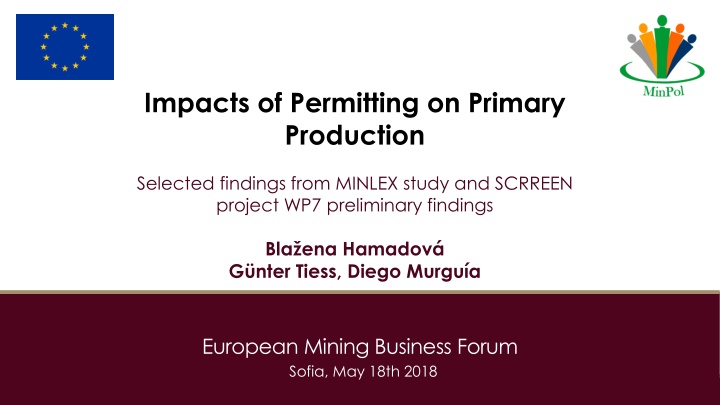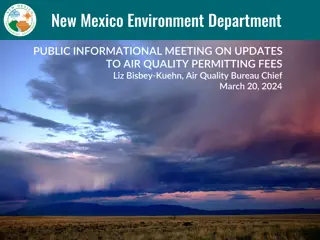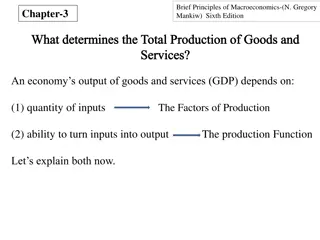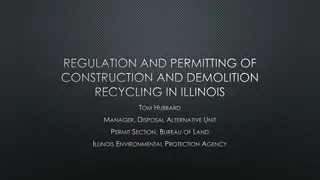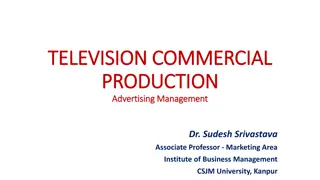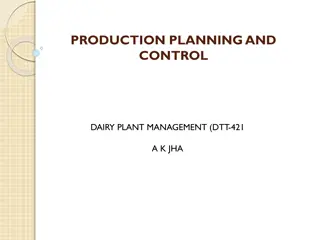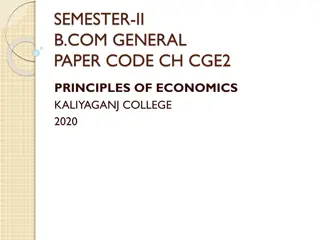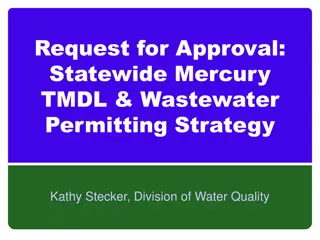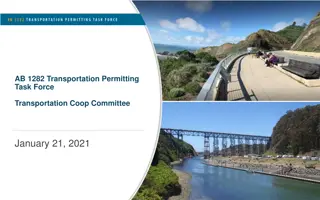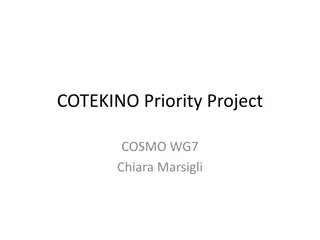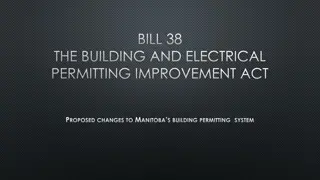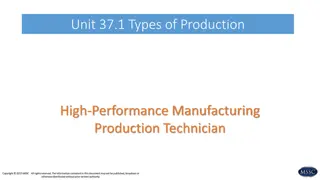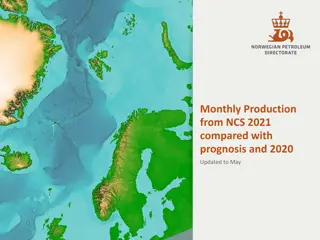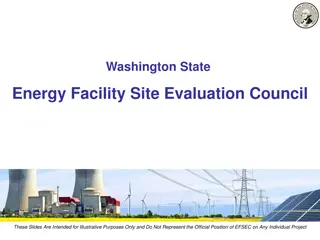Impacts of Permitting on Primary Production: Insights from MINLEX Study and SCRREEN Project
This study delves into the impacts of permitting on primary production in the European mining sector. It highlights the legal framework, permitting regimes, and the need for effective procedures. The research covers diverse aspects such as mineral ownership, authorities involved, and examples like the Norra Kӓrr heavy REE deposit. Findings reveal the complexity and variations in permitting procedures across European countries, with a focus on achieving sustainable mineral supply through aligned regulations and investment criteria.
Download Presentation

Please find below an Image/Link to download the presentation.
The content on the website is provided AS IS for your information and personal use only. It may not be sold, licensed, or shared on other websites without obtaining consent from the author.If you encounter any issues during the download, it is possible that the publisher has removed the file from their server.
You are allowed to download the files provided on this website for personal or commercial use, subject to the condition that they are used lawfully. All files are the property of their respective owners.
The content on the website is provided AS IS for your information and personal use only. It may not be sold, licensed, or shared on other websites without obtaining consent from the author.
E N D
Presentation Transcript
Impacts of Permitting on Primary Production Selected findings from MINLEX study and SCRREEN project WP7 preliminary findings Bla ena Hamadov G nter Tiess, Diego Murgu a European Mining Business Forum Sofia, May 18th 2018
Contents MINLEX Findings Overview of the content EU dimension MS level Legal Framework Permitting Regime/Mineral Ownership Authorities and permitting process Why do we need and effective permitting procedures? Example of permitting impact: Norra K rr heavy REE deposit 2
Results the Report constitutes the most complete and comprehensive study in the subject of laws and permitting procedures governing the non-energy extractive industry in the 28 Member States of the European Union EU dimension 28 country reports Analysis of TFEU 48country experts EU legislation - Internal Market (Services Directive, (mining/environmental lawyers, Concession Directive, PPD, TD, AD, PQD), Nature geologists, engineers, etc.) Protection (EIA, Habitats and Birds D., EWD)and Health 65 reviewers (authorities, ministries, and Safety, (OHS, CMD) industry associations, etc.) Permitting in MS 95Fact Sheets on EU legislation SWOT analysis of EU and MS legislation and implementation Over 1000laws collected Annexes (Country Reports, EU aquis Fact Sheets, Court Cases analysis) 3
EU dimension o The analysis of the EU legislation shows that the TFEU, relevant conventions, and the EU Internal Market, Environmental, Nature Conservation, Water, Emissions, Chemical Safety, Extractive Waste and Occupational Health & Safety Directives provide an adequate legal framework for the NEEI sector and establish principles and guarantees alignedwith globally accepted mineral investment criteria. o This legal framework combined with the EU s Raw Materials Strategy framework (RMI, EIP-RM), provide a strong basis for achieving a sustainable supply of minerals from European sources and sets the right conditions for the MSs to streamline their NEEI permitting procedures. o The implementation of EU legislation differ by country some of them are applying even stricter conditions. 4
MS level Legal Framework o The structure of legal framework in MSs is very heterogeous, however the exist some simmilarities (e.g. principal mining act,definition of ownership, establish provisions for permitting) o On the other hand, the number of laws relevant for NEEI permitting procedures per MS varies widely. ES and HR are those MSs with the highest number of relevant laws (112 and 110 respectively), followed by IT (96), UK (69) and LV (65), far higher than the average (40). In contrast, the CZ (7) and MT (14) appear as those jurisdictions with the lowest amount of laws. Differencies can be explained by the administrative divisions of MSs or by the level of fragmentation of the relevant acts. o In general, legal pieces are not easily found translated into English, and if they exist, they are often unofficial translations (only informative - cannot be used for legal purposes) 5
Permitting regimes, Mineral ownership o Permitting regime centralised, decentralised or a mixed one is determined by the administrative division of the MSs and depends on type of mineral resources o Onshore majority mixed (12) or centralised (11); Offshore centralised (21), only DE decentralised o Only 9 jurisdictions have one-stop shops even though the concept of one-stop shop has been promoted for years as good practice o Mineral ownership In 9 MSs high-value minerals are state-owned and low-value minerals are landowned (CZ, FR, IE, IT, LU, PL, PT, SK, UK). While the state claims ownership of all mineral resourcesin eight MSs (BG, CY, HR, HU, LT, RO, SI, ES), in six MSs (BE, EE, DK, LV, MT, NL) all (onshore) mineral resources belong to the landowner (except for offshore minerals which also belong to the state). The fourth group are five MSs (AT, DE, EL, SE, FI) where low-value minerals belong to the landowner and the rest are free for any operator to request a concession to the state 6
Authorities and permitting process o The number of co-authorities is smaller for exploration than for extraction permits permitting procedures differ not only by the type of mineral and its ownership, but also according to the mineral development phase. o Exploration and extraction permits have different procedures (e.g. in CZ, EE, EL, SE) (except for MT which has an integrated procedure) and are often controlled by a different number of authorities. The number of authorities involved depends on the type of mineral, the size and complexity of the (planned) operation, the location of the works (e.g. protected areas) and the mineral ownership. o Permitting success rates are higher for exploration than for extraction the reasons for the rejection of applications are manifold and depend on the context of each MS. o Delays of permitting procedures may be caused by one or a combination of the following factors: a lack of statutory timeframes (deadlines), lack of specialised staff and technical capacity, insufficient competence and ability to handle conflicts of interest and seek compromises, lack of knowledge to apply existing guidance documents (e.g. on EC s guidance on NEEO and Natura 2000). 7
Permitting framework in the EU COMPLEX Reducing investment security? Heterogeneous Unpredictable? Delays? Not flexible 9
Why do we need effective permitting procedures? Increasing competition between different land- uses, such as urbanization and other non-mineral development, nature and cultural heritage protection Local oposition, lack of awareness about real impacts/benefits of mineral development
Example of permitting impact Norra K rr heavy REE deposit/ TasmanMetals (Sweden) o explored by (Canadian) Leading Edge Materials Corp (Tasman Metals), o TasmanMetals Economic Assessment study (2012) > mining 1.5 Mt / year (mineral resource base of 59 Mt) with 80% total recovery of 3 critical REOs (Y, Dy and Tb) > correspond to current demand. o production prognosed for early 2017 o dependent on environmental permitting procedure o TasmanMetals did not get permit; (re)submission to Swedish Mining Inspectorate December 2017. o Mining Lease already granted in 2013 is now under re-assessment process (status from April 2018) o Delays in obtaining permits from government > Questionable investment security
Investment security? (Not) streamlined procedures (No. of Acts and competent authorities) Delays in getting permit Success rate (?) Social acceptance (?) Policy strategy and priorities 12
MinPol - Agency for International Minerals Policy www.minpol.com Bla ena Hamadov , Minerals Policy Junior Specialist E-mail: blazena.hamadova@minpol.com Thanks for your attention! 13 WIOML - 3RD ANNUAL CONFERENCE, TOLEDO 2017 - BLA ENA HAMAOV
Key results of the SWOT analysis (EU perspective) STRENGTHS Strong legal and policy framework internal market, environment, access to justice, etc. Free moovement of capital, persons and services, recognition of diplomas, certificates and qualifications, Initiatives and Guidances Raw Materials Initiativ and its Strategic Implementation Plan, EU Guidance on NEEI and Natura2000 WEAKNESSES Non-energy minerals supply does not figure among defined Policy Areas of the EU NEEI sector is not properly covered by Concessions Directive Inconsistencies in Nature Directives (e.g. evel of protection strictness) and EIA Directive (competent expert) OPPORTUNITIES THREATHS Stricter rules (environmental, water protection) = financial challenge to investors Promotion of international cooperation Encouraging of innovation and technological progress Incorporation of LCA in Concessions Dir. One stop shops to be promoted in Services Dir. Streamlining the environmental permitting (new EIA Dir.) EIB as an important Stakeholder for funding NEEI? 14
Key results of the SWOT analysis (MS perspective) STRENGTHS Transposition of EU legislation Security of tenure is guaranteed by national legislation Some MSs (e.g. FI, PL, ES) apply financial incentives as a policy tool to attract investments A good practices One stop shops and electronic permitting systems, stakholders engagement, reconciliation with nature conservation, land useplanning practice) OPPORTUNITIES WEAKNESSES Different clasification legal status of minerals ((non)- claimable, (non-) reserved, (non-)concession, etc.) Lack of statistics on permitting success rate in some countries Cost of permitting procedures may be too high, especially for SMEs which constitute a large part of the NEEI sector. THREATHS EU fuded research (Horizon 2020) as a tool for boosting the national RM policy framework Some MS already adopted RMI in thier policies Support mineral development project where it may promote socio-economic development Cross-border planning in suppy-demand of RM, e.g. in aggregates More dissemination in successfuly applied of high quality EIA/AA procedure High population density and competing land-uses Appeals based on weak technical arguments= unpredictable permitting proces development Stricter rules (environmental, water protection) = financial challenge to investors Lack of communication to the public concerned 15
